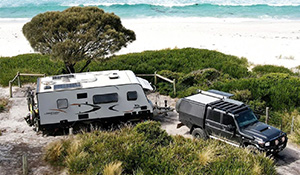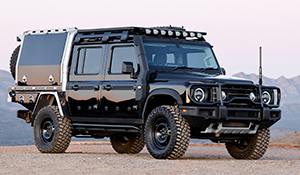FEATURE – Toyota LandCruiser dual cab custom
Australia, apparently, led the way in development of the 70 Series LandCruiser dual cab that reached our shores in 2012. But there was another LandCruiser dual cab that debuted more than a decade earlier. The LandCruiser presented here has been inspired by an official Toyota model that was produced in small numbers for a short time, and one that is largely unknown outside its home country.
The Brazilian Connection
Australia may think it has a long association with Toyota off-roaders, but Brazil’s is even longer. In 1958, when the first LandCruisers were imported here for use on the Snowy Mountains hydro scheme, LandCruiser assembly was already underway in Brazil (although some sources say assembly actually started in 1959). The decision to assemble ‘Cruisers in Brazil wasn’t due to the size of the market there, but more for the fact that Brazilian laws prevented the sale of fully-imported, complete vehicles. Basically, if you wanted to sell your cars in Brazil, you had to build them there. Chevrolet had been one of the first marques to establish assembly operations in Brazil, but they were soon followed by Ford, Volkswagen, Fiat and Mercedes-Benz, to name a few. In the case of Toyota, those early Brazilian-built LandCruisers were clones of the Japanese-made 40 Series SWB, but as the South American operation grew, so too did the level of local content.

By the early 1960s, Brazilian LandCruisers had acquired an official name – Bandeirante. Derived from the Portuguese bandeira (‘flag’ in English), Bandeirante referred to ‘explorers’ - specifically the organisers of privately-funded expeditions through Brazil’s interior in the 17th Century. So, given the LandCruiser’s go-anywhere capability, the ‘explorer’ tag seems appropriate! By the mid-1960s – at the same time Australia was starting local assembly of Toyota Tiara sedans – the Brazilian LandCruiser/Bandeirante swapped the maker’s engine for a Mercedes-Benz-derived diesel. Why Toyota of Brazil chose a Mercedes-type engine is unclear, but the compact four-cylinder diesel persisted, upgraded as required until 1994, when a Toyota 14B diesel was once again used. The Brazilian plant had become largely self-sufficient by the early 1970s, with almost every component locally made. In 1983, the range of short and long wheelbase wagons were joined by a pickup, which featured a cabin area and tray largely similar to the FJ45 LWB pickup, but rolled on a unique 2955mm wheelbase, and featured a load area 2140mm long and 1715mm wide.

40 Series Continues
As most Toyota LandCruiser aficionados know, the 40 Series ended production in 1984, replaced by the 70 Series, but in Brazil, the 40 Series continued. While still noticeably a LandCruiser, the post-1984 Bandeirantes featured touches unique to Brazil, including rectangular headlights and a chunky plastic grille. Later changes included improved brakes, a 5-speed transmission and updated instrumentation. In 1991, Brazil lifted its ban on vehicle imports, which meant the monopoly enjoyed by local manufacturers was over. For Toyota of Brazil, that was bad news, as the Bandeirante was noticeably outdated. Still, 40 Series production continued, but with private buyers drifting to newer, better models, the company had to rely more heavily on military and government contracts. It was a Brazilian Army contract that’s alleged to have led to the development of a dual cab model, which debuted in 1999. Common to all the Bandeirante dual cab pickups was a 3355mm wheelbase, narrower rear door (that’s clearly derived from the front door), HJ45-style rear corner windows and a shorter tray area – 1800mm – compared to the single cab pickup, but the front end of the body, along with the mechanicals, was as per the single cab. Two years after this variant arrived, Toyota closed its Brazilian operations for good, largely because it wasn’t considered feasible to upgrade the 40 Series design that was now four decades old, nor the 14B engine to meet Brazilian emissions regulations. As the last “new” model released before the Brazilian Toyota plant closed, it’s estimated only around 200 of the FJ45-style dual cab Bandeirantes were built. Most went to the military as originally intended, with the remainder used by government agencies. None are believed to have been sold to private buyers.

Escaping Brazil
These Bandeirantes were largely unknown outside Brazil, but at the dawn of the new millennium, a few appeared in the USA. Jonathan Ward, better known as the man behind ICON 4x4 in the US, was running TLC 4x4 (classic LandCruiser restorations) at the time and working directly with Toyota Japan on design and development of what would become the FJ Cruiser. Ward had visited the Brazilian Toyota plant before its closure and fell in love with the dual cab Bandeirante, but found they were impossible to get out of Brazil – at least for an individual. But thanks to the intervention of Toyota HQ, a bundle of parts and dual cab-specific body panels were duly shipped to Ward in the US; enough for TLC to produce a handful – believed to be no more than five – fitted with modern engines, running gear and other upgraded features, but still with that classic 40 Series look.

The Costa Rican Connection
Surprisingly, the vehicle presented here isn’t one of those Bandeirante dual cabs, but a scratch-built mockup inspired by the Brazilian original. Offered for sale at Bonhams’ Amelia Island auction in March, the vehicle pictured here started life as a standard 1979-model HJ45 single cab pickup, which has been subjected to same major modification. The pickup was sourced from a Costa Rican coffee plantation by the Vintage Cruiser Co.; a highly-regarded Florida-based LandCruiser restoration and modification company on a par with TLC 4x4. While it looks like a Bandeirante – and has clearly been influenced by the Brazilian model – comparing this dual cab with a genuine Bandeirante and the differences become apparent, including the lack of strengthening ribs in the lower body and a noticeably different load bed.

Stretch and Save
Transforming this single cab into a five-seater required building all new body panels and a modified frame, with the load bed and fuel tank all custom made to suit as part of a full frame-off restoration. While it retains its classic looks, this LandCruiser has been upgraded with a bunch of modern off-road parts that would make it capable of tackling just about anything you could throw at it. Under the bonnet is a fully-rebuilt Toyota 14B 3.7-litre direct-injection four-cylinder diesel, matched to a 5-speed transmission – just like the last Bandeirantes. The dual cab rolls on 16-inch ProComp alloy wheels with Mickey Thompson Baja MTZ tyres, while Brazilian-made AVM manual locking hubs on the front wheels link this tribute to it inspiration. Hydraulic disc brakes have been added to the front wheels, while the lighting has been upgraded with Truck-Lite LED headlights and Luminix LED auxiliary lights in the custom front bar, to which a Warn ‘Zeon 8’ winch has also been fitted. ICON4x4 parts include side mirrors and (not fitted) swing-out rear bumper mounts for a spare tyre and jerrycan. Ensuring this creation is safeguarded against the worst off-road trails, the entire underbody has been sprayed with Rhino Linings, as has the load bed, while all the fasteners are electroplated stainless steel. Inside, the upgrades include a Kenwood sound system with touch screen activation, Garmin GPS, Bluetooth connectivity, Apple CarPlay compatibility, Vintage Air air conditioning and custom-made seats.

The Aussie Connection
Not immediately apparent is the amount of “Australia” that’s gone into this build, but it’s a reflection of how Aussie-designed and made 4x4 accessories are valued around the world that a number have been fitted. Leading the way here are Old Man Emu NitroCharger Sport shocks as part of a custom suspension kit on both axles. Differential air lockers from ARB have been fitted, combined with an ARB on-board twin compressor and air reservoir. ARB air hose couplings have also been added to both bumpers, designed primarily for tyre inflation, but also useful for pneumatic tool operation. Finally, a Series 40 snorkel from our own Safari Snorkels has been fitted.

More Spec, More Tech
Also on the long list of upgrades and additions made in the construction of this vehicle is a Painless Performance dual battery system and 10-circuit fuse block that’s designed to handle accessories and auxiliary systems, run off a pair of premium Panasonic batteries. A full custom wiring loom, Dakota Digital instrumentation, custom-made dash switches, satellite radio, front and rear cameras, dual USB plugs in the glovebox and built-in smartphone sound system ports modernise the experience, while a PowerBright 2300w 12V sine wave inverter has also been fitted, along with custom underseat storage, the aforementioned custom seats, all-new carpeting and a new headliner.

Strong Seller
How much this custom took to build is unrecorded, but it came to Bonhams Amelia Island auction with a US$90,000-120,000 reserve. On the day, it met this, selling for an impressive US$115,500 (AU$153,500 approx.). Finished in archetypal LandCruiser Dune Beige, this one-off has been described as ideal for the Copperstate Overland, a classic 4x4 rally held annually in Arizona, but looking at its spec and features, it’d be ideal for exploring Aussie trails, too! At the same auction, a less radical 1980-model SWB BJ40 LandCruser was offered, fully restored to near-original condition, including a fully rebuilt B Series diesel and 4-speed manual transmission. Finished in a unique Cadet Blue and featuring leather and alcantara upholstery, as well as LED headlights, power steering and a modern sound system, this unit came to auction with a minimum US$65,000 guiding range, but sold for US$47,300 (AU$62,860); below estimate, but still a whopping price for an older LandCruiser.
For more details from this auction, go to: <a href="www.bonhams.com">bonhams.com</a>
Words: Mike Ryan
Photos: Courtesy of RM Sothebys




































